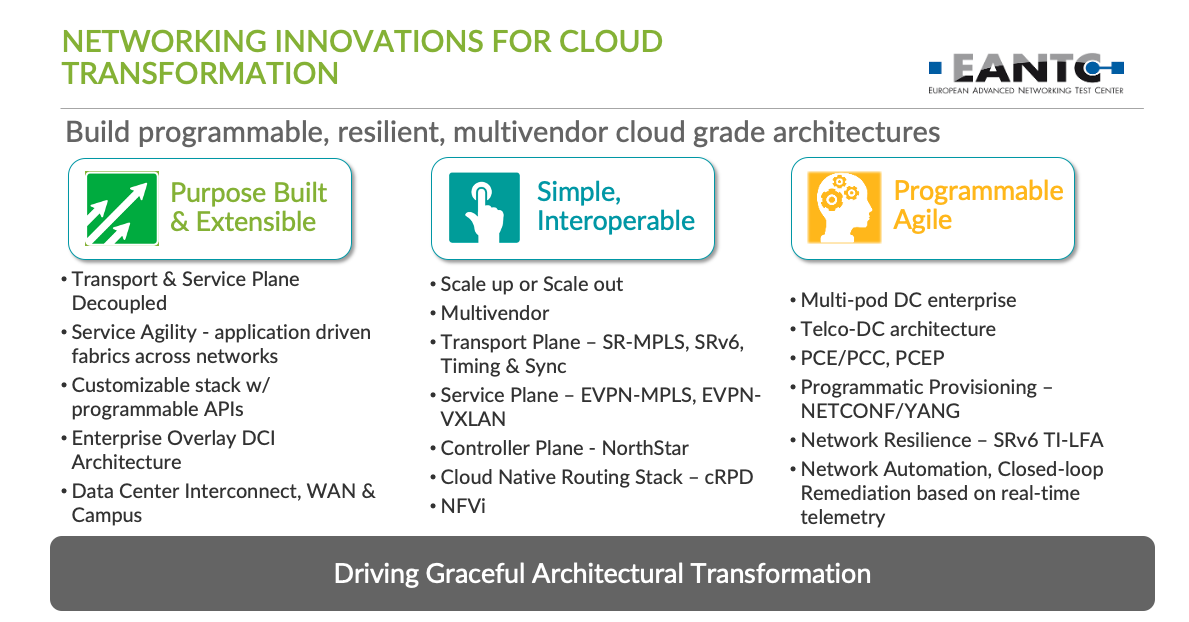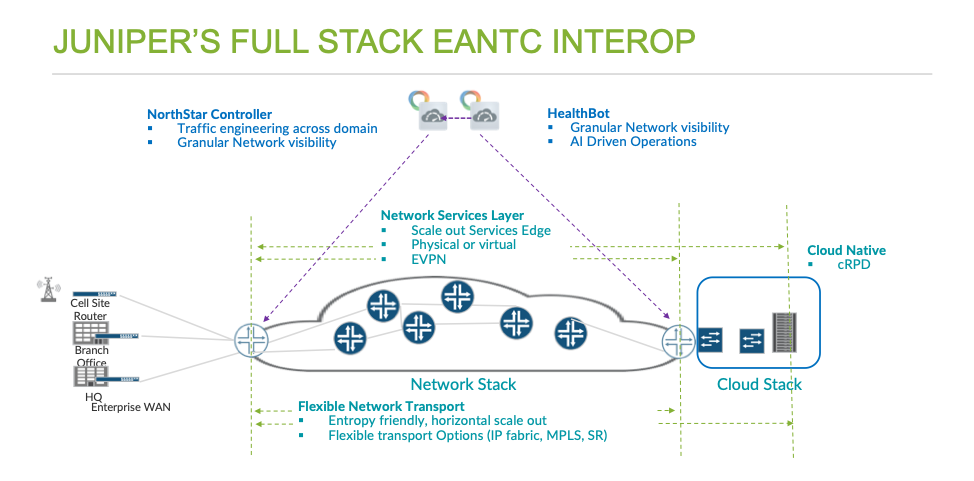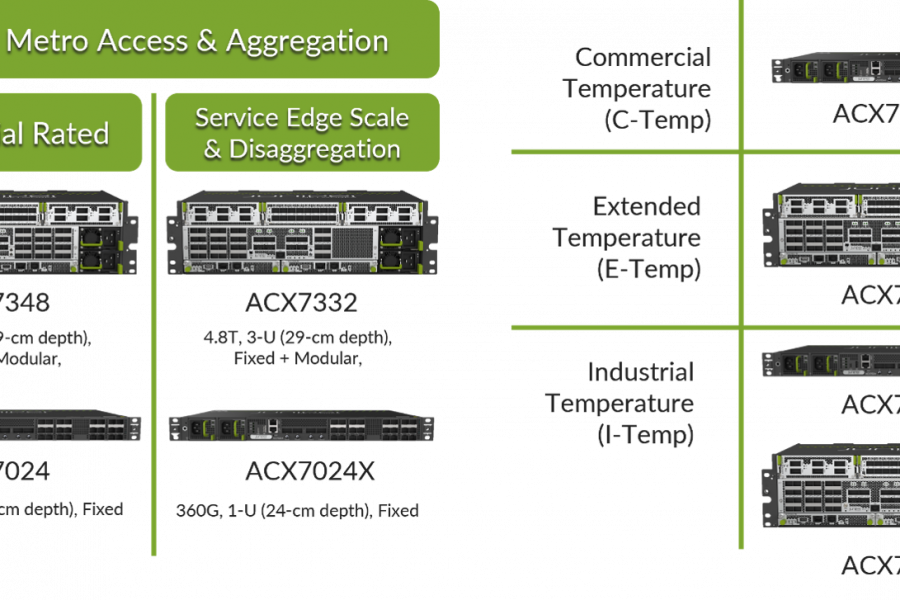This is the first of a series of seven blogs about network interoperability.
Juniper Networks continues to demonstrate leadership in routing innovation, recently participating in MPLS + SDN + NFV World Congress multi-vendor interoperability testing conducted by the European Advanced Networking Test Center (EANTC). The testing, conducted in Berlin, will be showcased later this year at MPLS World Congress 2020. The test report is publicly available and can be found here.
With the advent of the cloud era, networking has changed significantly over last several years. Fundamental business outcomes of the cloud include service agility, enhanced user experience and service customization, all while controlling costs. Modern network architectures can achieve these outcomes by following a few simplified architectural concepts.

Decoupling Services from Transport
The most important enhancement is to simplify networks and increase service agility to decouple network services from the underlying network transport. Such separation enables different network layers to evolve independently. Operators can utilize all available transport options – MPLS, SPRING or IP fabrics – and allow service nodes to negotiate separate service tunneling with each service peer based on its capabilities. Such clean separation not only speeds up new service rollouts, but also enables operators to utilize third-party networks, including the internet, to improve their market reach.
The separation of different network layers extends even further to include controllers. Controllers enable path computation and traffic engineering across different network domains and across different transport technologies like MPLS and SPRING. This simplifies service rollouts by accommodating increasingly disperse application workloads running on the network.
Importantly, this separation of controller, service and transport layers also allows operators to select best in class products at each layer.
Importance of Interoperability Testing
In the cloud era, a typical application must traverse several different network domains as it travels to an end user from a distant cloud and back. Service providers thrive on open standards innovation and their end customers ultimately benefit. A key aspect of open standard innovation is the interoperability testing that vendors conduct between each other to ensure that the latest and greatest technologies they develop actually interwork with each other. Only when such open standard innovations exist, with interoperability proven, are service providers able to choose best in class products.
Interoperability testing helps drive consensus. Emerging drafts and requests for comment (RFCs) always leave room for interpretation. Every vendor interprets the drafts or RFCs in the context of their own products. However, if discrepancies arise during interop events, robust discussions occur in the vendor community and one common interpretation ultimately evolves.
Customers generally loathe proprietary implementations for the fear of vendor lock-in. But interop events provide proof of interoperability with other vendors, easing customer concerns about proprietary technology creep.
Juniper Interop Leadership
In the recent EANTC Interop testing, Juniper participated in full stack interop testing with Cisco, Nokia and others in the following areas:
- Transport plane – Timing, SR, SRv6
- Service plane – EVPN
- Controller plane – NorthStar, HealthBot
- Cloud Native Routing Stack: cRPD
 Again, it is not sufficient to simply decouple the different layers of the stack. The different layers must also interoperate with other vendors and each other.
Again, it is not sufficient to simply decouple the different layers of the stack. The different layers must also interoperate with other vendors and each other.
Transport Layer (Underlay)
Segment Routing (SR) simplifies the transport layer by eliminating the need to run MPLS protocols. Additionally, with the help of a controller, SR allows each service to determine its own path (using label stack) through the network as per its SLA requirements without maintaining any state in the network.
Juniper has participated in SR interop testing since 2015. This year, we also participated in testing SRv6 – and we were even ready to test SRm6 ahead of our industry peers!
Application (Service) Layer
EVPN revolutionized L2 services by liberating them from 30-year old bridging-based technologies by using the control plane to distribute MAC/IP reachability. By breaking dependency on hop-by-hop bridging, EVPN decouples L2 services from the transport technologies. Additionally, EVPN’s all-active multi-pathing improves service scale and availability, on top of any transport technology available.
As a leader in EVPN implementation, we are proud to have led the industry in EVPN interop testing since 2014.
Controller Layer
NorthStar SR Controller: NorthStar determines the optimal path for an application based on monitored network operating parameters and encodes that path as a label stack on the service routers. With embedded Junos routing protocols, NorthStar is always in complete sync with the network it controls. Most importantly, with a programmable interface, NorthStar allows operators to make customized path selection decisions based on business logic.
Juniper has been participating in interop testing with the NorthStar Controller since 2015. Additionally, we’ve demonstrated NorthStar not only as an SR controller but also as an RSVP-TE network controller.
HealthBot: HealthBot enables closed loop automated control to make real-time decisions based on real time network conditions. To ensure granular applications level SLAs in a network, complete network visibility is critical. HealthBot testing at EANTC 2020 demonstrated Juniper’s multi-vendor, multi-layer network automation solution with deep telemetry, analytics and remediation across the whole stack.
Cloud Native Routing Stack
Building web scale networking infrastructure requires simple, open, scale-out, secure and automated software architectures. This requires disaggregation of the technology stack to ensure that applications can run in any cloud, cloud workloads can run on any device and software is not locked to hardware. The EANTC interoperability testing included Junos cRPD for both services and transport.
We will detail our participation in this year’s EANTC interop testing in these areas in a series of follow-up blogs. The first follow-up blog will highlight SRv6 interop testing at EANTC.
Conclusion
Most customers loathe proprietary implementations for fear of vendor lock-in. But interop events provide proof of interoperability with other vendors.
Juniper has the richest set of routing protocol implementations available in the industry today. The EANTC interop event is yet another proof point of our leadership in the transformation of networking for the cloud era.
Join us on June 10 (US/EMEA) and June 11 (APAC) to discover how network architectural shifts create business value at our Juniper Virtual Summit for Cloud & Service Providers. Register here.


